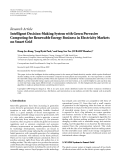
ISSN: 2615-9740
JOURNAL OF TECHNICAL EDUCATION SCIENCE
Ho Chi Minh City University of Technology and Education
Website: https://jte.edu.vn
Email: jte@hcmute.edu.vn
JTE, Volume 19, Issue 06, 2024
22
Evaluating the Total Active Power Loss under Different Placement of
Photovoltaic Power Plants Using an Effective Northern Goshawk Optimization
Dao Trong Tran*, Bach Hoang Dinh
Ton Duc Thang University, Ho Chi Minh City, Vietnam
*Corresponding author. Email: trantrongdao@tdtu.edu.vn
ARTICLE INFO
ABSTRACT
Received:
21/03/2024
This research presents a detailed evaluation of the total active power loss
(TAPL) under different placements of photovoltaic power plants (PVPs) in
the electric distribution network (EDN) IEEE 33-node. Three study cases
have been conducted to serve the initial intention, including 1) optimizing
both rated power and position of a PVP on selected EDN; 2) optimizing
the positions of different quantities of PVPs independently to the grid with
the same rated power, and 3) optimizing a sole PVP with a wide range of
rated power. In all three study cases, northern goshawk optimization
(NGO) is the primary search method for determining the essential results
and data, especially in the last two cases, after proving its competitive
performance in the first case compared to other methods. The results in
study cases 2 and 3 indicated that for reaching the minimum value of
TAPL, placing many PVPs independently on the grid simultaneously is the
best implementation. Notably, the placement 7 PVPs with a total rated
power of 2800kW has resulted in a significantly better TAPL than all the
results in study case 3. However, for the situation where EDN can only
adopt a sole PVP, all the data and results presented in study case 3 are also
good academic material.
Revised:
24/04/2024
Accepted:
04/09/2024
Published:
28/12/2024
KEYWORDS
Total active power loss;
Photovoltaic power plants;
Electric distribution network;
Northern goshawk optimization;
Renewable energy.
Doi: https://doi.org/10.54644/jte.2024.1559
Copyright © JTE. This is an open access article distributed under the terms and conditions of the Creative Commons Attribution-NonCommercial 4.0
International License which permits unrestricted use, distribution, and reproduction in any medium for non-commercial purpose, provided the original work is
properly cited.
1. Introduction
In power systems, distribution power grids (EDNs) receive electricity from transmission power grids
and distribute the electricity to loads [1]. Nowadays, customers use more high power devices such as
electric chargers for car, leading to high voltage drop and power loss [2]. So, solutions to the problem
need to be found, and solar energy is one of the most effective solution [3]. Thanks to the benefits of
economics and engineering, installing electric components in EDNs has become a hot trend [2],
especially distributed generators (DGs) using solar radiation and wind speed. The added DGs can reduce
power from the grid and current from the source to each load, leading to the reduction of voltage drop
and power loss. Therefore, the paper focuses on the optimal placement of DGs based on solar radiation.
The target is to improve the voltage and lessen the power loss based on the optimal determination of the
location and power of photovoltaic power plants (PVPs) in EDNs.
Many previous studies have used different types of DGs for different purposes, such as general DGs
[4]–[7], wind power plants (WPPs) [8]–[12], PVPs [13]–[16], and both WPPs and PVPs [17]–[21]. In a
study [4], three standard IEEE EDNs with 33, 69, and 85 nodes were employed to find DGs' most
suitable power and position to reduce the total power loss. In the study [5], only one standard IEEE EDN
with 33 nodes was tested to simulate the impacts of injected active and reactive power from DGs.
Another study [6] found other solutions with the combination of PVPs and WPPs in the standard IEEE
33-node EDN. in order to violate high voltage drop and reduce switching number when implementing
network reconfiguration and using DGs in the IEEE 69-node configuration [7]. In the study [8], modern
wind turbines based on Double Fed Induction Generator (DFIG) were connected to the EDNs to reduce
loss and enhance voltage. In the study [9], high benefits of adding WPPs appropriately in EDNs were
analyzed based on results from optimization tools’ comparisons. In the study [10], the cutting-edges of
energy storage system was applied in three unbalanced phase-EDNs. More specifically, the steady-state























